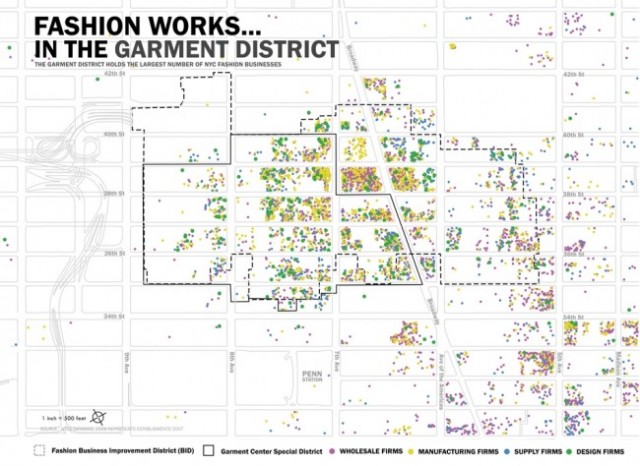For a quarter-century, New York’s Garment District has enjoyed its own tailored zoning code. The code restricts landlords from converting manufacturer-rented buildings into offices fetching higher rents, and essentially keeps the industry alive in its current configuration. Comprised of wholesalers, manufacturers, tailors, and designers both local and international, the Garment District has long been the core of the New York fashion scene, which is a dominant part of the global fashion industry.
In a more prosperous time, the Garment District produced clothing for most of the country, and with that, provided an equally substantial number of jobs. Immigrants and self-starters alike found opportunity in the crowded side streets south of Time Square that amounted to a buzzing network of shops and factories.
Today, the story is largely the same. Fed by three major design schools, it is considered the Silicon Valley of the fashion world. However, cheaper wages abroad in places like China and Latin America have lured many manufacturers overseas–a move not uncommon in any manufacturing, but one that now threatens the New York fashion scene as developers look to replace vacancies with offices.
The Bloomberg Administration is currently reviewing a plan to adjust the district’s zoning code to enable further commercial-zoned development. Since the last change enacted in 1987, landlords have been required to keep a 1:1 ratio of garment-related industry and other business in their buildings. Now, faced with economic pressures, the Bloomberg Administration has proposed a new 1:6 ratio: one part manufacturing to six parts business. This would decrease fashion-related work space by some 7 million square feet.Industry workers argue that the current allotted area is still necessary to meet needs for showrooms, storage, and manufacturing. Although the number is decreasing, there are still approximately seven thousand garment-related jobs in the district, many employing recent immigrants. The Design Trust for Public Space, a New York City-based think tank, has compiled arguments for preserving the district from the pressures of New York real estate at madeinmidtown.org.
They protest that on a national level, the Garment District represents one of the last remaining enclaves of U.S. manufacturing for consumer goods. This localized economy has been declared by many as a valuable, distinctive piece of the city, and that by outsourcing manufacturing, it will take away the proximity factor that makes the Garment District work. Not only can this cut production time, but as fuel prices soar, shipping costs offset the advantage of cheap, overseas labor. The clustering of these businesses creates a unique environment of competition and efficiency.
The Design Trust for Public Space‘s report quoted New York-based designer Yeohlee Teng, who maintains that “You’re talking about an ecosystem and an interdependency. It’s like a coral reef: you don’t know how the reef will survive and what it will do if certain elements are removed.”
(Image: Made in Midtown)
